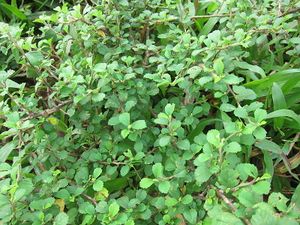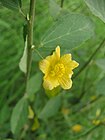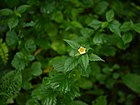Note: This is a project under development. The articles on this wiki are just being initiated and broadly incomplete. You can Help creating new pages.
Difference between revisions of "Sida rhombifolia - Devabala"
Chaithrika (talk | contribs) |
m (Arun93 moved page Cuban jute - Sida rhombifolia to Sida rhombifolia - Devabala: Name corrected) |
||
| (9 intermediate revisions by 2 users not shown) | |||
| Line 1: | Line 1: | ||
[[File:800px-Sida Rhombifolia - കുറുന്തോട്ടി 01.JPG|thumb|right|''Sida rhombifolia'', ''jelly leaf'']] | [[File:800px-Sida Rhombifolia - കുറുന്തോട്ടി 01.JPG|thumb|right|''Sida rhombifolia'', ''jelly leaf'']] | ||
| + | '''Sida rhombifolia''' is widely distributed in the tropics and occurs in almost all countries of tropical Africa. | ||
| + | ==Uses== | ||
| + | {{Uses|Fever}}, {{Uses|Indigestion}}, {{Uses|Snakebites}}, {{Uses|Headaches}}, {{Uses|Boils}}, {{Uses|Cramps}}, {{Uses|Rheumatism}}, {{Uses|Toothache}}, {{Uses|Chapped lips}}, {{Uses|Pimples}} | ||
| + | ==Parts Used== | ||
| + | {{Parts Used|Leaves}}, {{Parts Used|Fruits}}, {{Parts Used|Roots}} | ||
| − | + | ==Chemical Composition== | |
| + | Alkaloids, steroids and saponins. In DPPH scavenging assay the IC50 value was found to be 50 μg/mL which was not comparable to the standard ascorbic acid<ref name="chemical composition"/> | ||
| + | ==Common names== | ||
| + | {{Common names|kn=|ml=Vankuruntotti|sa=|ta=Kurundotti|te=|hi=Sahadeva|en=Cuban jute, Jelly leaf}} | ||
| − | + | ==Properties== | |
| − | + | Reference: Dravya - Substance, Rasa - Taste, Guna - Qualities, Veerya - Potency, Vipaka - Post-digesion effect, Karma - Pharmacological activity, Prabhava - Therepeutics. | |
| − | + | ===Dravya=== | |
| − | |||
| − | |||
| − | |||
| − | |||
| − | |||
| − | == | + | ===Rasa=== |
| + | Tikta (Bitter), Kashaya (Astringent) | ||
| + | ===Guna=== | ||
| + | Laghu (light), Snigda (heavy), Picchila (sticky) | ||
| + | ===Veerya=== | ||
| + | Sheeta (cold) | ||
| + | ===Vipaka=== | ||
| + | Madhura (sweet) | ||
| + | ===Karma=== | ||
| + | Vata, Kapha | ||
| + | ===Prabhava=== | ||
| − | * '' | + | ==Habit== |
| − | * | + | {{Habit|Subshrub }} |
| + | |||
| + | ==Identification== | ||
| + | ===Leaf=== | ||
| + | {{Leaf|Simple|Alternate|Arranged alternately along the stem, approximately 3/4 to inches long, with petioles that are less than 1/3 the length of the leaves}}<ref name="Leaf"/> | ||
| + | |||
| + | ===Flower=== | ||
| + | {{Flower|Unisexual|4 to 8 mm long|Yellow|5|The seedlings with 2 heart-shaped cotyledons}} | ||
| + | |||
| + | ===Fruit=== | ||
| + | {{Fruit|simple|7–10 mm|clearly grooved lengthwise, Lowest hooked hairs aligned towards crown||many}} | ||
| + | |||
| + | ===Other features=== | ||
| + | |||
| + | ==List of Ayurvedic medicine in which the herb is used== | ||
| + | * [[Vishatinduka Taila]] as ''root juice extract'' | ||
| + | |||
| + | ==Where to get the saplings== | ||
| + | ==Mode of Propagation== | ||
| + | {{Propagation|Seeds}}, {{Propagation|Cuttings}}. | ||
| + | |||
| + | ==How to plant/cultivate== | ||
| + | Grows wild in a range of soil types, from fertile to degraded condition<ref name="How to plant/cultivate"/> | ||
| + | |||
| + | ==Commonly seen growing in areas== | ||
| + | {{Commonly seen|disturbed fields}}, {{Commonly seen|roadsides}}, {{Commonly seen|rocky areas}}. | ||
| + | |||
| + | ==Photo Gallery== | ||
| + | <gallery class="left" caption="" widths="140px" heights="140px"> | ||
| + | (Sida rhombifolia) flower at Madhurawada.JPG | ||
| + | |||
| + | (Sida rhombifolia) flower at Safilguda.JPG | ||
| + | |||
| + | |||
| + | Angled Sida Sida rhombifolia WLB IMG 0212 13.jpg | ||
| + | |||
| + | |||
| + | Arrow-leaf Sida (6140515729).jpg | ||
| + | |||
| + | |||
| + | Arrowleaf.jpg | ||
| + | |||
| + | |||
| + | Broom Jute Sida (3912618198).jpg | ||
| + | |||
| + | |||
| + | Cuban jute (1386542260).jpg | ||
| + | |||
| + | |||
| + | Cuban jute - Flickr - pellaea (1).jpg | ||
| + | |||
| + | </gallery> | ||
| + | |||
| + | ==References== | ||
| + | |||
| + | <references> | ||
| + | <ref name="chemical composition">[https://www.ncbi.nlm.nih.gov/pubmed/24144125 "Phytopharmacological"]</ref> | ||
| + | |||
| + | <ref name="Leaf">[http://www.flowersofindia.net/catalog/slides/Jelly%20Leaf.html "leaves description"]</ref> | ||
| + | |||
| + | <ref name="How to plant/cultivate">[http://tropical.theferns.info/viewtropical.php?id=Sida%20rhombifolia "Cultivation Details"]</ref> | ||
| + | </references> | ||
| + | |||
| + | ==External Links== | ||
| + | * [https://herbpathy.com/Uses-and-Benefits-of-Sida-Rhombifolia-Cid4563 Sida rhombifolia-uses, remedies, side effects] | ||
| + | * [https://uses.plantnet-project.org/en/Sida_rhombifolia_(PROTA) Sida rhombifolia on plantnet.org] | ||
| + | * [https://www.ncbi.nlm.nih.gov/pubmed/21970621 Anti-inflammatory and anti-oxidant properties of Sida rhombifolia] | ||
| + | * [http://www.holistic-online.com/Herbal-Med/_Herbs/h_sida-rhombifolia.htm Sida rhombifolia on holostic online.org] | ||
[[Category:Herbs]] | [[Category:Herbs]] | ||
| + | [[Category:Malvaceae]] | ||
| + | |||
| + | [[Category:Ayurvedic herbs that don't have seed photos]] | ||
Latest revision as of 14:06, 25 June 2019
Sida rhombifolia is widely distributed in the tropics and occurs in almost all countries of tropical Africa.
Contents
- 1 Uses
- 2 Parts Used
- 3 Chemical Composition
- 4 Common names
- 5 Properties
- 6 Habit
- 7 Identification
- 8 List of Ayurvedic medicine in which the herb is used
- 9 Where to get the saplings
- 10 Mode of Propagation
- 11 How to plant/cultivate
- 12 Commonly seen growing in areas
- 13 Photo Gallery
- 14 References
- 15 External Links
Uses
Fever, Indigestion, Snakebites, Headaches, Boils, Cramps, Rheumatism, Toothache, Chapped lips, Pimples
Parts Used
Chemical Composition
Alkaloids, steroids and saponins. In DPPH scavenging assay the IC50 value was found to be 50 μg/mL which was not comparable to the standard ascorbic acid[1]
Common names
| Language | Common name |
|---|---|
| Kannada | |
| Hindi | Sahadeva |
| Malayalam | Vankuruntotti |
| Tamil | Kurundotti |
| Telugu | |
| Marathi | NA |
| Gujarathi | NA |
| Punjabi | NA |
| Kashmiri | NA |
| Sanskrit | |
| English | Cuban jute, Jelly leaf |
Properties
Reference: Dravya - Substance, Rasa - Taste, Guna - Qualities, Veerya - Potency, Vipaka - Post-digesion effect, Karma - Pharmacological activity, Prabhava - Therepeutics.
Dravya
Rasa
Tikta (Bitter), Kashaya (Astringent)
Guna
Laghu (light), Snigda (heavy), Picchila (sticky)
Veerya
Sheeta (cold)
Vipaka
Madhura (sweet)
Karma
Vata, Kapha
Prabhava
Habit
Identification
Leaf
| Kind | Shape | Feature |
|---|---|---|
| Simple | Alternate | Arranged alternately along the stem, approximately 3/4 to inches long, with petioles that are less than 1/3 the length of the leaves |
Flower
| Type | Size | Color and composition | Stamen | More information |
|---|---|---|---|---|
| Unisexual | 4 to 8 mm long | Yellow | 5 | The seedlings with 2 heart-shaped cotyledons |
Fruit
| Type | Size | Mass | Appearance | Seeds | More information |
|---|---|---|---|---|---|
| simple | 7–10 mm | clearly grooved lengthwise, Lowest hooked hairs aligned towards crown | many | {{{6}}} |
Other features
List of Ayurvedic medicine in which the herb is used
- Vishatinduka Taila as root juice extract
Where to get the saplings
Mode of Propagation
How to plant/cultivate
Grows wild in a range of soil types, from fertile to degraded condition[3]
Commonly seen growing in areas
disturbed fields, roadsides, rocky areas.
Photo Gallery
References
External Links
- Ayurvedic Herbs known to be helpful to treat Fever
- Ayurvedic Herbs known to be helpful to treat Indigestion
- Ayurvedic Herbs known to be helpful to treat Snakebites
- Ayurvedic Herbs known to be helpful to treat Headaches
- Ayurvedic Herbs known to be helpful to treat Boils
- Ayurvedic Herbs known to be helpful to treat Cramps
- Ayurvedic Herbs known to be helpful to treat Rheumatism
- Ayurvedic Herbs known to be helpful to treat Toothache
- Ayurvedic Herbs known to be helpful to treat Chapped lips
- Ayurvedic Herbs known to be helpful to treat Pimples
- Herbs with Leaves used in medicine
- Herbs with Fruits used in medicine
- Herbs with Roots used in medicine
- Herbs with common name in Hindi
- Herbs with common name in Malayalam
- Herbs with common name in Tamil
- Herbs with common name in English
- Habit - Subshrub
- Index of Plants which can be propagated by Seeds
- Index of Plants which can be propagated by Cuttings
- Herbs that are commonly seen in the region of disturbed fields
- Herbs that are commonly seen in the region of roadsides
- Herbs that are commonly seen in the region of rocky areas
- Herbs
- Malvaceae
- Ayurvedic herbs that don't have seed photos








